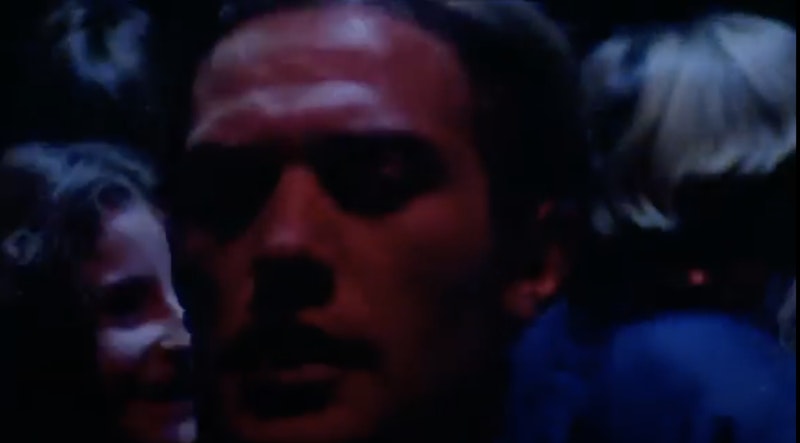Lucio Fulci died in early-1996, alone in his apartment, exhausted by diabetes and a brutal life filled with real death all around. He stopped taking his insulin in March, but in January, he was the belle of the ball at the Fangoria convention in New York City, where horror and genre fans packed every screening and appearance featuring the overlooked master, who was treated like a perverted peasant in his own country. Here, in America, at the very end of his life, he saw how far his work had gone and how long it had lasted. Zombi 2, also known as Zombie, or Zombie Flesh Eaters, or The Island of the Living Dead, or Nightmare Island, Woodoo, Zombie: The Dead Walk Among Us, Zombie 2: The Dead Are Among Us, Gli Ultimi Zombi… is the 1979 film that made money and secured the rest of Fulci’s modest career.
Fulci is still most renowned for his gialli, but a movie like Contraband, while not as consistently brilliant as The New York Ripper, has one of the most beautiful and invigorating sequences I’ve ever seen. Set to the song “You Are Not the Same” by Fabio Frizzi and Cricket, Contraband turns into the pure cinema of disco epilepsy as Saverio Marconi is introduced dancing with beautiful men and women, his face lit pink-purple against everyone else’s silver blue and bright white. Fulci is Sam Peckinpah’s only equal when it comes to turning otherwise routine genre scenes (and entire movies) into formally radical expressions of cinematic violence, ecstasy, and suspense. Although not as cleanly executed as Peckinpah’s montages, Fulci made many more movies with much less money and time, so it’s remarkable that a relatively unknown movie like Contraband features as many spectacular scenes as it does.
As in most Fulci movies, plot is incidental: there are smugglers, other smugglers, cops, and the innocents around them. Does it really matter who’s selling uncut cocaine to who? This is all a means to reach to as many shoot-outs, torture, and slow-motion death as possible. Unlike the American “torture porn” that polluted popular cinema for most of the 2000s, Fulci’s extreme violence is brought to life and made beautiful by the exuberance of his filmmaking. I’ve never found any of his movies grim, even the early-1980s trilogy with Catriona MacColl. The practical effects are amazing but they’re obviously not real; along with the dislocation of the bad dubbing, this allows a slow-motion montage of a man’s brains blown out the back of his head through his mouth at the edge of a racetrack. Red, white, black and blue brain matter soars with grace as horses pass in the background.
Less beautiful but still profound is a scene of lead detective Fabio Testi’s wife, played by Ivana Monti, tortured with a blowtorch while her husband is forced to listen over the phone, and then raped by another thug demanding ransom. Forget bad dubbing: when it comes to Monti screaming, along with whoever dubbed her in English, there are few sounds more intense. And this blowtorch scene lasts for a long time. Despite the relatively primitive practical effects (still miles ahead of anything CGI can do), you’ll never see anything as graphic as this in an American movie, especially a routine crime thriller. Fulci himself shows up for the final shootout, blasting what looks like an Uzi with glee as dozens of his anonymous Italian gangsters and policemen are mowed down by each other. Testi and Monti survive, while Marconi ends up with half of his neck removed by a shotgun.
And all of this is set to poppy music by Cricket, and filmed with an endless chain of quick dollies, snap zooms, sudden musical sequences, and action set pieces that put Peckinpah in the conversation. In a way, Fulci was even more brilliant, if only because he was more free and made many more movies than Peckinpah, but he was just as trapped in genre as the man that made The Wild Bunch and wished he could’ve followed it up with Play It As It Lays. Fulci could express his insanity on film over time, and watching this movie in decent quality for the first time, previously unremarkable scenes suddenly feature incredible shot designs and rhythms that I missed while overwhelmed the first two times. All of Fulci’s movies are like that, brimming and manic with violence and the kind of risk that’s so hard to capture on film.
“Do you remember that Saturday night?” Yes. Yes I do. I remember that nightclub scene. Coming out of nowhere 10 minutes into the movie, it’s a quintessential Fulci montage, something that perhaps approaches what he said he was always trying to accomplish: “Artuadian cinema.” Fulci’s frenetic filmmaking—from the camera movements to the editing to the production design to the music to the performances to the ecstasy of violence—are distilled here, in less than five minutes. A major key disco sequence hardly sounds violent, but it’s all in Marconi’s face, bathed in Hell red. He doesn’t have to say a single word for the rest of the movie, because he’s been introduced more concisely and artfully than any dialogue exchange could ever approach.
Contraband can’t quite make the top of Fulci’s heap, if only because of the amount of relatively boring scenes of cops and criminals talking in rooms, however well (or bizarrely) lit. It isn’t as tight or vibrant as The New York Ripper, nor as chic as The Psychic, but despite its imperfections, this is a perfectly realized film. The shootout that ends the movie is a celebration of cinematic violence for its own sake, one where the director participates along with many other men we don’t recognize or care about. It doesn’t matter. This is ecstatic action filmmaking, a movie that feels dangerous, made with the kind of dedicated insanity missing from American popular cinema.
—Follow Nicky Smith on Twitter: @nickyotissmith

